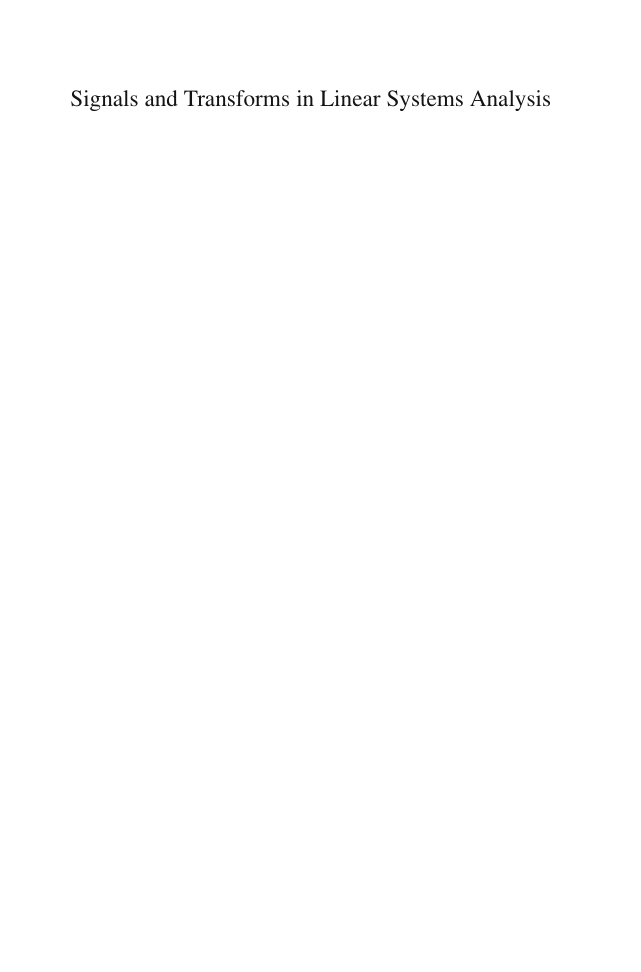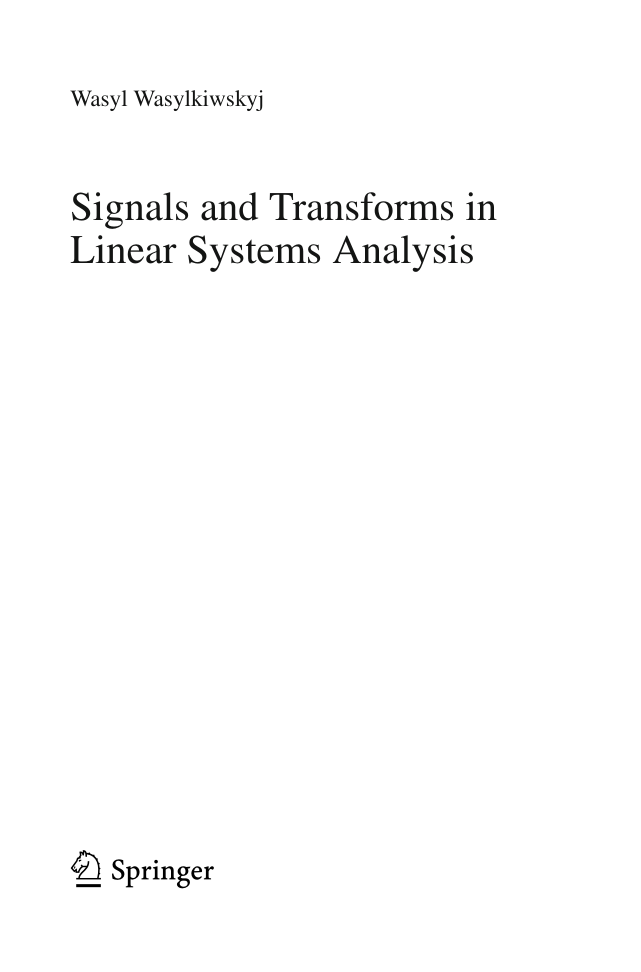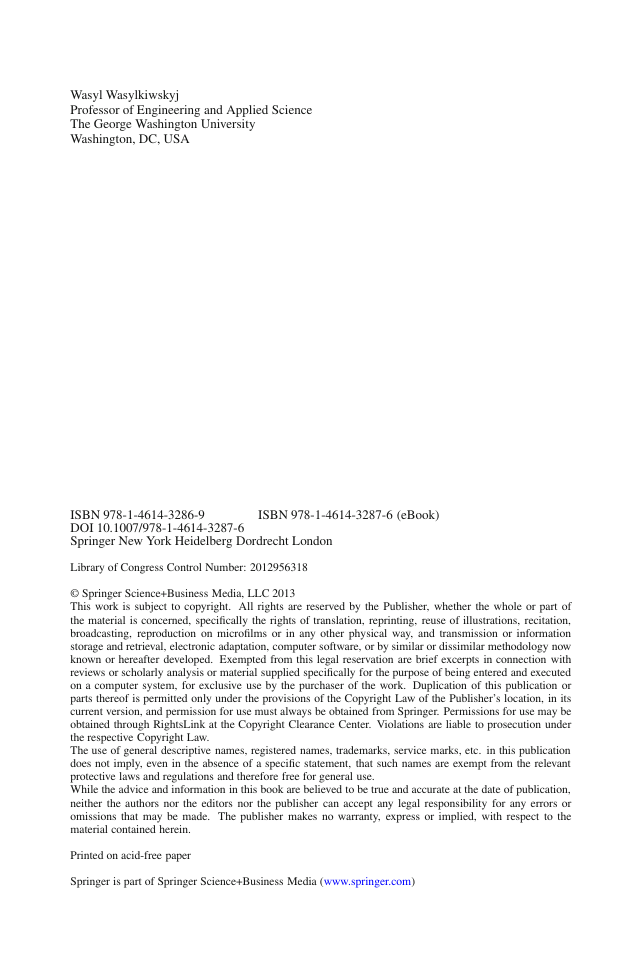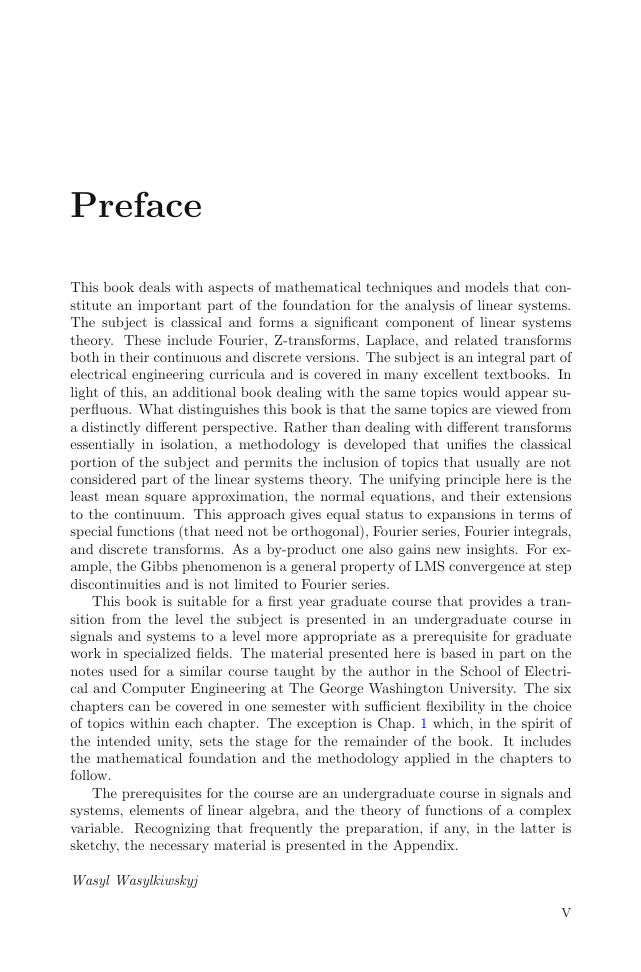Preface
Contents
Introduction
Chapter
1 Signals and Their Representations
1.1 Signal Spaces and the Approximation Problem
1.2 Inner Product, Norm and Representations by Finite Sumsof Elementary Functions
1.2.1 Inner Product and Norm
1.2.2 Orthogonality and Linear Independence
1.2.3 Representations by Sums of OrthogonalFunctions
1.2.4 Nonorthogonal Expansion Functionsand Their Duals
1.2.5 Orthogonalization Techniques
Orthogonalization via the Gram Matrix
The Gram–Schmidt Orthogonalization
1.3 The LMS Approximation and the Normal Equations
1.3.1 The Projection Theorem
1.3.2 The Normal Equations
1.3.3 Generalizations of the Normal Equations
1.3.4 LMS Approximation and Stochastic Processes*
1.4 LMS Solutions via the Singular Value Decomposition
1.4.1 Basic Theory Underlying the SVD
1.4.2 Solutions of the Normal EquationsUsing the SVD
1.4.3 Signal Extraction from Noisy Data
1.4.4 The SVD for the Continuum
1.4.5 Frames
1.4.6 Total Least Squares
1.4.7 Tikhonov Regularization
1.5 Finite Sets of Orthogonal Functions
1.5.1 LMS and Orthogonal Functions
1.5.2 Trigonometric Functions
1.5.3 Orthogonal Polynomials [1]
Legendre Polynomials
Laguerre Polynomials
Hermite Polynomials
1.6 Singularity Functions
1.6.1 The Delta Function
Definition of the Delta Function
Limiting Forms Leading to Delta Functions
1.6.2 Higher Order Singularity Functions
1.6.3 Idealized Signals
1.6.4 Representation of Functions with StepDiscontinuities
1.6.5 Delta Function with Functions as Arguments
1.7 Infinite Orthogonal Systems
1.7.1 Deterministic Signals
1.7.2 Stochastic Signals: Karhunen–Loeve Expansion
Chapter
2 Fourier Series and Integrals with Applications to SignalAnalysis
2.1 Fourier Series
2.1.1 Pointwise Convergence at Interior Pointsfor Smooth Functions
2.1.2 Convergence at Step Discontinuities
2.1.3 Convergence at Interval Endpoints
2.1.4 Delta Function Representation
2.1.5 The Fejer Summation Technique
2.1.6 Fundamental Relationships Between the Frequencyand Time Domain Representations
Parseval Formula
Time and Frequency Domain Convolution
Symmetries
2.1.7 Cosine and Sine Series
Sine Series
2.1.8 Interpolation with Sinusoids
Interpolation Using Exponential Functions
Interpolation Using Cosine Functions
2.1.9 Anharmonic Fourier Series
2.2 The Fourier Integral
2.2.1 LMS Approximation by Sinusoids Spanninga Continuum
2.2.2 Transition to an Infinite Observation Interval:The Fourier Transform
2.2.3 Completeness Relationship and Relation to FourierSeries
2.2.4 Convergence and the Use of CPV Integrals
2.2.5 Canonical Signals and Their Transforms
The Delta Function
The Unit Step Function
The Rectangular Pulse Function
Triangular Pulse Function
Exponential Functions
Gaussian Function
2.2.6 Basic Properties of the FT
Linearity
Symmetries
Time Shift and Frequency Shift
Differentiation
Inner Product Invariance
Convolution
Integration
Causal Signals and the Hilbert Transform [16]
Initial and Final Value Theorems
Fourier Series and the Poisson Sum Formula
2.2.7 Convergence at Discontinuities
2.2.8 Fejer Summation
2.3 Modulation and Analytic Signal Representation
2.3.1 Analytic Signals
2.3.2 Instantaneous Frequency and the Methodof Stationary Phase
2.3.3 Bandpass Representation
2.3.4 Bandpass Representation of Random Signals*
2.4 Fourier Transforms and Analytic Function Theory
2.4.1 Analyticity of the FT of Causal Signals
2.4.2 Hilbert Transforms and Analytic Functions
2.4.3 Relationships Between Amplitude and Phase
2.4.4 Evaluation of Inverse FT Using Complex VariableTheory
2.5 Time-Frequency Analysis
2.5.1 The Uncertainty Principle
2.5.2 The Short-Time Fourier Transform
2.6 Frequency Dispersion
2.6.1 Phase and Group Delay
2.6.2 Phase and Group Velocity
2.6.3 Effects of Frequency Dispersion on Pulse Shape
2.6.4 Another Look at the Propagation of a GaussianPulse When B"' (W0) =0
2.6.5 Effects of Finite Transmitter Spectral Line Width*
2.7 Fourier Cosine and Sine Transforms
Chapter
3 Linear Systems
3.1 Fundamental Properties
3.1.1 Single-valuedness, Reality, and Causality
3.1.2 Impulse Response
3.1.3 Step Response
3.1.4 Stability
3.1.5 Time-invariance
3.2 Characterizations in terms of Input/Output Relationships
3.2.1 LTI Systems
3.2.2 Time-varying Systems
3.3 Linear Systems Characterized by Ordinary DifferentialEquations
3.3.1 First-Order Differential Equations
3.3.2 Second-Order Differential Equations
Time-varying Systems
LTI System
3.3.3 N-th Order Differential Equations
Time-Varying Systems
Standard Form.
Equivalent N-Dimensional First-Order Vector Form.
Feedback Representation.
Time-invariance
Chapter
4 Laplace Transforms
4.1 Single-Sided Laplace Transform
4.1.1 Analytic Properties
4.1.2 Singularity Functions
4.1.3 Some Examples
4.1.4 Inversion Formula
4.1.5 Fundamental Theorems
Properties
LT of Polynomial and Exponential Signals
Periodic Signals
4.1.6 Evaluation of the Inverse LT
Rational Functions
Transcendental Functions
4.2 Double-Sided Laplace Transform
4.2.1 Definition and Analytic Properties
4.2.2 Inversion Formula
Example 1
Example 2
Example 3
Example 4
4.2.3 Relationships Between the FT and the Unilateral LT
Determination of the FT from the Unilateral Laplace Transform
Determination of the Unilateral Laplace Transform from the FT
Chapter
5 Bandlimited Functions Sampling and the Discrete FourierTransform
5.1 Bandlimited Functions
5.1.1 Fundamental Properties
5.1.2 The Sampling Theorem
5.1.3 Sampling Theorem for Stationary RandomProcesses*
5.2 Signals Defined by a Finite Number of Samples
5.2.1 Spectral Concentration of Bandlimited Signals
5.2.2 Aliasing
5.3 Sampling
5.3.1 Impulse Sampling
5.3.2 Zero-Order Hold Sampling and Reconstruction
5.3.3 BandPass Sampling
5.3.4 Sampling of Periodic Signals
5.4 The Discrete Fourier Transform
5.4.1 Fundamental Definitions
5.4.2 Properties of the DFT
Periodicity
Orthogonality
Matrix Properties
Parseval Identities
Time and Frequency Shift
Convolution
Chapter
6 The Z-Transform and Discrete Signals
6.1 The Z-Transform
6.1.1 From FS to the Z-Transform
6.1.2 Direct ZT of Some Sequences
6.1.3 Properties
Time Shift
Forward.
Backward Shift.
Time Convolution
Frequency Convolution
Initial Value Theorem
Differentiation
6.2 Analytical Techniques in the Evaluation of the Inverse ZT
6.3 Finite Difference Equations and Their Use in IIR and FIRFilter Design
6.4 Amplitude and Phase Relations Using the Discrete HilbertTransform
6.4.1 Explicit Relationship Between Real and ImaginaryParts of the FT of a Causal Sequence
6.4.2 Relationship Between Amplitude and Phaseof a Transfer Function
6.4.3 Application to Design of FIR Filters
Appendix
A Introduction to Functions of a Complex Variable
A.1 Complex Numbers and Complex Variables
A.1.1 Complex Numbers
A.1.2 Function of a Complex Variable
A.2 Analytic Functions
A.2.1 Differentiation and the Cauchy–RiemannConditions
A.2.2 Properties of Analytic Functions
A.2.3 Integration
A.3 Taylor and Laurent Series
A.3.1 The Cauchy Integral Theorem
A.3.2 The Taylor Series
A.3.3 Laurent Series
A.4 Singularities of Functions and the Calculus of Residues
A.4.1 Classification of Singularities
Isolated Singularities
Definitions.
Laurent Series for Functions with Isolated Singularities.
Multivalued Functions and Extended Singularities.
A.4.2 Calculus of Residues
The Residue Theorem
Computation of Residues
Bibliography
Index
















 2023年江西萍乡中考道德与法治真题及答案.doc
2023年江西萍乡中考道德与法治真题及答案.doc 2012年重庆南川中考生物真题及答案.doc
2012年重庆南川中考生物真题及答案.doc 2013年江西师范大学地理学综合及文艺理论基础考研真题.doc
2013年江西师范大学地理学综合及文艺理论基础考研真题.doc 2020年四川甘孜小升初语文真题及答案I卷.doc
2020年四川甘孜小升初语文真题及答案I卷.doc 2020年注册岩土工程师专业基础考试真题及答案.doc
2020年注册岩土工程师专业基础考试真题及答案.doc 2023-2024学年福建省厦门市九年级上学期数学月考试题及答案.doc
2023-2024学年福建省厦门市九年级上学期数学月考试题及答案.doc 2021-2022学年辽宁省沈阳市大东区九年级上学期语文期末试题及答案.doc
2021-2022学年辽宁省沈阳市大东区九年级上学期语文期末试题及答案.doc 2022-2023学年北京东城区初三第一学期物理期末试卷及答案.doc
2022-2023学年北京东城区初三第一学期物理期末试卷及答案.doc 2018上半年江西教师资格初中地理学科知识与教学能力真题及答案.doc
2018上半年江西教师资格初中地理学科知识与教学能力真题及答案.doc 2012年河北国家公务员申论考试真题及答案-省级.doc
2012年河北国家公务员申论考试真题及答案-省级.doc 2020-2021学年江苏省扬州市江都区邵樊片九年级上学期数学第一次质量检测试题及答案.doc
2020-2021学年江苏省扬州市江都区邵樊片九年级上学期数学第一次质量检测试题及答案.doc 2022下半年黑龙江教师资格证中学综合素质真题及答案.doc
2022下半年黑龙江教师资格证中学综合素质真题及答案.doc